Endurance Events and Lactate Testing
With Emphasis on the Triathlon
12 of 19
The primary use of lactate testing is to
assess performance over time
Is the Training Working?
The primary use for lactate testing is to assess performance over time. In other words:
- is the athlete progressing?
- is the training that is being used working?
Whatever training recommendations the athlete is using, they can be evaluated by lactate testing over time. Many of the training recommendations we have in our triathlon document are less intense than those recommended by others. So who is right?
There will never be general agreement on who is the best coach. But it is important that whatever is being recommended and executed is working. The less intense overall training is based on a particular philosophy of training. One does not have to subscribe to this training philosophy in order to use lactate testing effectively. Let’s contrast two different styles of training.
One is what we call the High/Low and the other is the Rocky philosophy. High/Low says that most of the volume will be at low intensity levels - regeneration or only slightly faster at what some coaches call “extensive”. When the athlete does train at higher intensities, small volumes of very high intensities are often best. Most of the training will be at low levels determined by the V4 test.
A contrasting philosophy is what we call "The Rocky philosophy" (from the movie Rocky in the 1970’s.) and is based on the concept that the higher the intensity the better and the more you do, the more your muscles will respond and the faster the athlete gets. There are a multitude of other training philosophies and the typical triathlete is familiar with many of them.
There is a masterful new article in the journal Sportscience (13, 32-53, 2009) by Stephen Seiler and Espen Tønnessen, entitled "Intervals, Thresholds, and Long Slow Distance: the Role of Intensity and Duration in Endurance Training." This article draws from many studies, and from detailed observation of the actual training practices of highly successful athletes in many disciplines. There have been few experiments with athletes that are already highly trained, because truly elite athletes are usually unwilling to risk a change in their training that may impair their performance for an important competition.
They found that, almost without exception, athletes that succeed best in endurance events spend most (75-85%) of their training days at low intensity (lactate levels below 2 mmol/l, at 50-65% VO2max), a small percentage at high intensity (short intervals with lactate above 6.0 mmol/l, at 90%-100% VO2max), and practically none anywhere near "lactate threshold." As athletes become more elite, and as they get closer to competition, the total volume of training often increases, with the intense workouts becoming more intense, and the easy workouts often becoming easier. But the overall proportion remains the same.
For many elite athletes, lactate testing is used, not only to monitor the results of training, but to calibrate training paces. Athletes often feel that low-intensity workouts are TOO easy, and must be a waste of their time. The better-trained the athletes, the better they will feel near their VO2max, and the more harm it will do if they train very much at this level. Usually these paces are expressed as a percentage of V4 speed (or power), and often heart rates are used as a practical field measurement of pace.
This same article reported an experiment by Esteve-Lanao with recreational runners comparing 2 matched groups using different intensity proportions:

This demonstrates the tendency of recreational athletes to train much too hard on the easy days and much too easy on the hard days. Since their training time is quite limited, they tend to go as fast as they can for as long as they train. And they often are not able to complete really intense training. Still these groups trained significantly differently. And the results were different: the Hi/Lo group improved their times significantly more at both 7 and 11 weeks than did the other group.
We mentioned a study on our lactate threshold page that was presented at ACSM on June 3, 2011. This study looked at the training of a world class 1500 m runner over a two year period. The study showed a substantial improvement for this athlete after he increased both the percentage of his low level training and high level training. During a two year period the percentage of training that was less than 80% of vVo2max was 20% in year 1 and in year 2 it was 55%. Also tempo runs were at a slower pace in year 2. From year 1 to 2, there was an increase in the proportion of training in the high intensity zone of 100 to 130% vVo2max from 7 to 10%. Performance changed substantially as the runner's best time in the 1500 m race went from 3:38.9 to 3:32.4 min:s from the beginning of year 1 to the end of year 2 (3:32.94 was the winning time at the Bejing Olympics in 2008.)
Ingham, S. A., B. W. Fudge, et al. (2011). Training monitoring; training delivery; middle distance running. American College of Sports Medicine, Denver, CO.
Not all studies show a significant advantage for Hi/Lo, but those that show a difference are in favor of the Hi/Lo general pattern.
Lactate testing is appropriate for any training philosophy. That is because lactate testing’s main function is to assess the training that has been done. If your training is working, the lactate test is the best report card to verify that it is working. Similarly, if your training is not working, the lactate test will show that. It is important to separate the lactate test from training. Lactate tests do help you train better, but mainly by helping each athlete find what works best for him or her. Here are two charts that assess the effects of training over time.
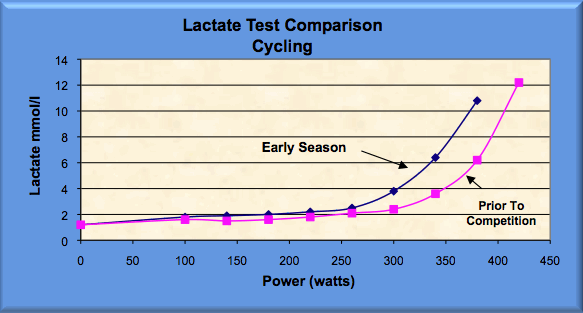
Doing it wrong - the coaches fault
The above chart suggests that the training for this athlete has been very effective. The charts indicate that the aerobic capacity of this athlete has improved substantially over the two periods. These two readings were about 3 months apart and probably one more test should have been conducted between the two tests. Also the second test used 9 separate stages plus a resting lactate. The first four of these stages were probably unnecessary. Let’s look at the following set of tests done for a good female triathlete and using only a three step test.
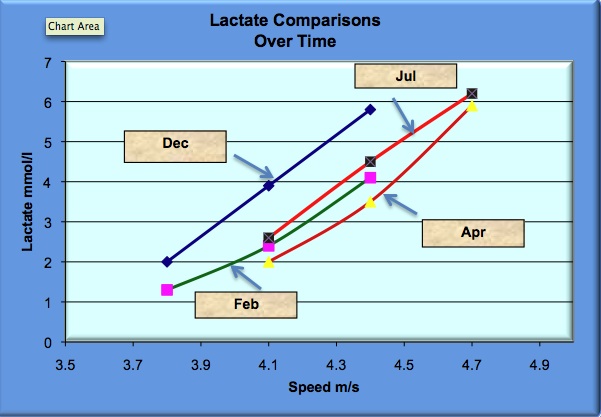
This athlete was preparing for an important competition in August. The tests for December, February and April were indicating a steady progression toward her goal of a good performance in mid August. But this was not to happen. The coach made a major mistake after the April tests and increased not only the percentage of high intensity workouts, but the general level of training intensity for all workouts and volume. The result was a leftward move of the lactate curve in July and a disappointing performance in August. This chart indicates that something went wrong between April and July. In this case it was too much intensity and the coach ignored the plan that produced the six months of successful training. Next is a coach who did not make these mistakes.
Doing it right - a good coach
The following are two examples from triathlon coach, Gareth Thomas, who operates the web site, Coach Gareth. Gareth has facilities in Los Angeles, Boise and Washington, D.C. and has coached some top level triathletes including world champions and top finishers at the Kona Ironman World Championships. He has written a book on the triathlon which you can get on his web site. In his book he devotes a chapter to lactate testing which he advocates very strongly. Here is how he finishes the section on lactate testing
I find it incredible that many coaches still don’t test their athletes. How can you advise and help someone if you have no information as to what they need? You need information to tailor your advice to suit the athletes. The cookie cutter approach just does not work.
It is my belief that lactate testing is just as important for the Novice athlete as it is for the Elite athlete. If you are genetically gifted, you can get to high level in endurance sports based on what you were born with. At the elite level, lactate testing helps refine training and improve already high standards.
At the Novice or “Age Grouper” level, genetic talent is limited so you need to maximize what you have. With blood lactate testing you optimize your training so that every second counts and so that you maximally develop your potential to its highest possible level.
The following are two examples from his book.
The first is for an elite male triathlete who has finished in the top 20 at Kona and has won an Ironman event. The blue lines represent a test done in August and the red lines represents a test done 9 weeks later just before his race in Kona.
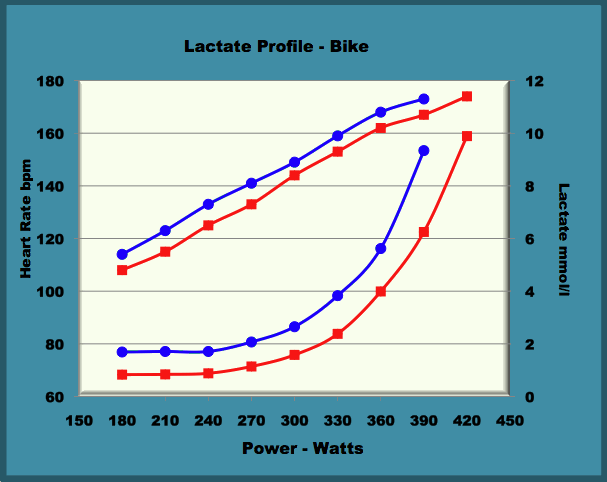
Here is what Gareth had to say about this test:
This testing represented the start of his Ironman preparation and his improvements just prior to the Hawaii ironman World Championships. To me it shows what accurate training can do for even an already well-conditioned athlete, in just nine weeks. The test was a continuous test of set intervals increasing by 30 watts every 4 minutes. Cadence was 90 rpm and he stayed seated in his aerodynamic position throughout. Over the nine week period his peak power increased from 390
watts to 420 watts while his weight dropped from 81 kilograms to 78 kilograms. This resulted in a peak power to weight ratio of 5.37 watts per kg compared to 4.82 watts per kg in August. His peak lactate and access to anaerobic contributions actually improved with lactate rising to 9.89 mmol from 9.34 mmol at peak power.At the same time his aerobic lactate levels plummeted to very low levels showing increased aerobic contributions at every workload. Heart rates dropped by up to 8 beats per minute at the same workloads showing central adaptations to the cardiovascular system.
He was ready and both Gareth and the athlete knew it. They also knew the training worked. This is the principal value of lactate testing, determining the best training practices for each athlete.
Let's look at an athlete on the other end of the scale. Here is an athlete who wants in her heart to do an Ironman but can hardly run a mile with out huffing and puffing. When she came to Gareth, she could hardly complete a 13 minute mile. She was healthy but had a very low aerobic capacity. Here are her results over a nine month period.
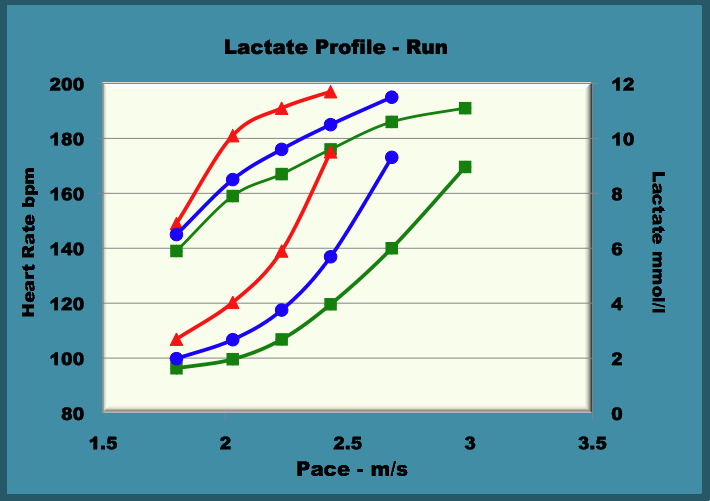
The red line represents her first test in July. The blue line represents her next text just two months later in September. The green line was from a test the following March, 8 months after starting to train. Here are some of Gareth's comments about her:
As you can see, lactate levels were higher than desired right from the start of the test, even at a brisk walk. Indeed, heart rates were somewhat high but to me this was just reflective of the effort she had to put out. I put her on to a training program that made her restrict heart-rate to under 150 bpm for eight weeks in an effort to force her to slow down and start building a stronger aerobic base. I told her that it would feel very easy and that she may feel that it was too
slow, but that she should trust it and stick with the regime. The blue data is the test data from eight weeks later.Her peak pace had increased from 11-minute mile pace to 10-minute mile pace for slightly less lactate produced. More importantly, lactate levels across the whole test had plummeted showing much improved aerobic capacity. Her heart rates had also started to fall at every workload and she reported feeling healthier, less stressed and her sugar cravings had almost disappeared. It was now with confidence that she could embark on more varied run training and her Ironman goal. The green line is the data taken the following March, a month prior to the Ironman.
Here is Gareth Thomas' Philosophy on lactate testing:
I take lactate samples from my athletes in many situations. Firstly, every athlete starts by doing laboratory based lactate tests for their particular sport. So for a cyclist we do an ergometer test, a runner does a treadmill test and the Triathlete does both of these tests and also a pool based swimming test. These tests form the standard benchmarks for “where the athlete is at”.
I like the lab because it is a very repeatable environment so we can compare tests done throughout the season and against previous years too. What I look to find out are the following:
- How low is the lactate at easy workloads and across the test – like it or not, the best endurance
athletes produce very little lactate even when they are working hard.
- How stable and constant is lactate production as intensity increases – that is, is the lactate
production steady or do they have a fragile aerobic engine spiked by slight increases in effort
- What is their peak lactate and anaerobic capacity like
- What is their power to weight ratio & how does this compare to other athletes
- What is the limiting factor for the athlete – strength, power, aerobic capacity, anaerobic capacity,
lactate tolerance, etc
- How is their body “made up” at this time – are they an aerobic machine, a sprinter or a perfect blend of aerobic and anaerobic abilities that suit their chosen sport? This will tell me how I need to manipulate their metabolic system so they can achieve their goals.
I need as much information as possible to be sure that I give the correct training stimulus to the
athlete. Every athlete has his or her own specific needs and in order to improve someone quickly and
healthily, I need the truth. There is no room for guesswork.
Doing it wrong - the athlete's fault
Below is another example of a very good triathlete and what happened when he ignored the coach’s training recommendations. This was not a case of the coach recommending the wrong workouts but the athlete himself not following the advice.
In December a one-speed swim test was done with this athlete. He swam 400 m in 5:04 and the lactate reading was 3.1 mmol/l. Based on this one swim, the V4 or tV4 was 5:00.7. Though we show two points on this chart, there was only one swim. The second point indicates where a second swim would probably lie if it had been done. The line is based on the analysis of thousands of swim tests performed by Jan Olbrecht.
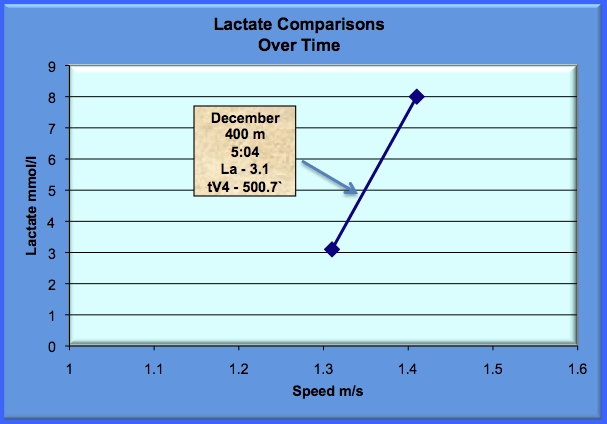
The athlete was given instructions to swim most of his 100 m intervals between 1:15 and 1:17. For 400 m intervals the target time was between 5:15 and 5:25 with most of the yardage closer to 5:25.
What he did was something else. He kept meticulous logs so it was easy to verify what he did. He regularly swam his hundreds close to 1:10 and his 400 m swims around 4:55. His comment was that all these felt easy. But here are the results:
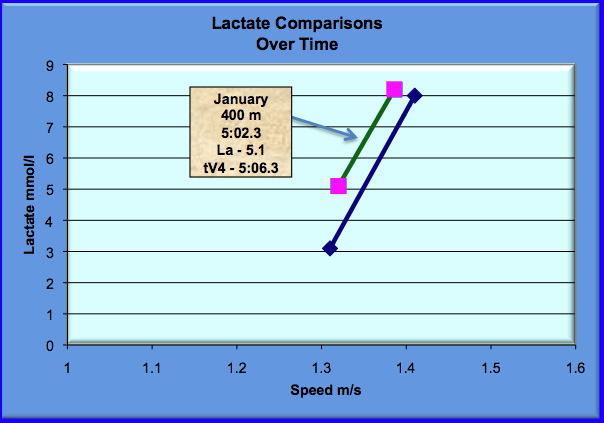
The athlete regressed. He couldn't believe it because his workouts for the previous six weeks felt good, his test felt good. So there must have been a mistake.
But there wasn't. A control test showed he was producing more lactate than expected at all speeds and thus his aerobic capacity had deteriorated. He was given new instructions to swim even slower than had been recommended six weeks previously. His 100 m swims were to be between 1:16 and 1:19 and his 400 m swims were to be between 5:20 and 5:30 with most of the volume near the slower pace. This time he did what was recommended. The results in six weeks were as follows:
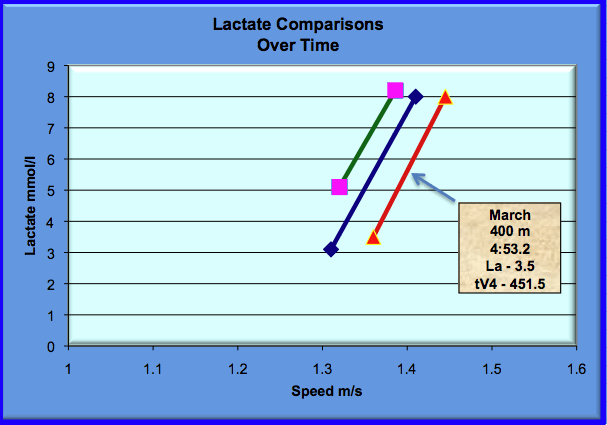
The athlete was faster and he got that way by going slower. Now this approach worked because of the slow speeds, but not all workouts were at slow speeds. A significant amount, about 10% of volume, was at high intensity, substantially above the V4 pace. (We are not recommending here this specific approach because there is not enough information given to execute it properly.) It is intended to show how one can evaluate a training philosophy and see if it is working for the athlete.
The most important use of lactate testing is to evaluate whatever training approach is being used. If the training approach emphasizes high intensity workouts, then lactate testing will tell the coach or athlete if this is working. If the training approach emphasizes long slow distance workouts, then lactate testing will tell the coach or athlete if this is working. If the training approach is based on emails from your favorite guru, then lactate testing will tell the coach or athlete if this is working.
Continue on to Module 13 on how to use lactate testing to set training paces
Module 13 of 19- how to use lactate testing to set and monitor training paces
